


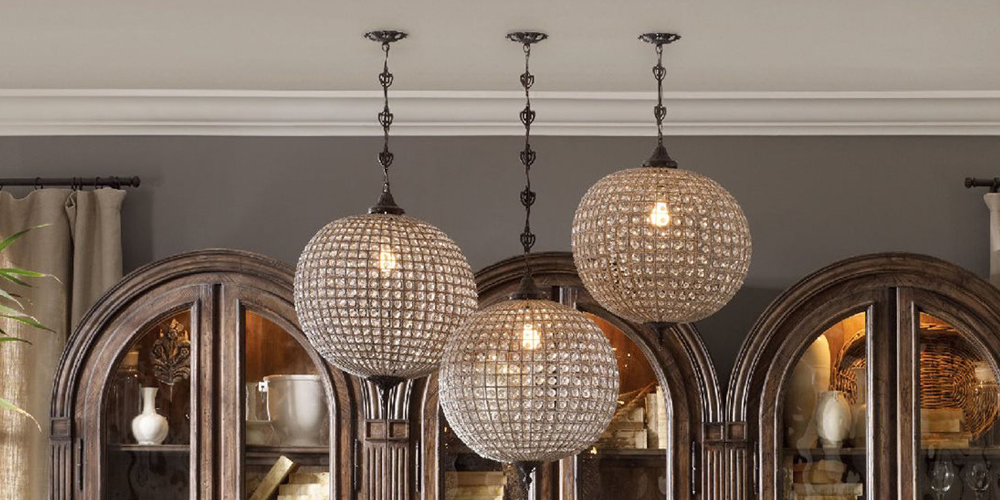
Overhead lighting or ceiling lighting refers to any fixture that is attached to the ceiling. These types of lights offer top-level lighting, and effectively illuminate a fixed radius area below. This category includes many sizes, styles, and types. Common overhead lights are pendants, chandeliers, recessed lights, track lights, and flush and semi-flush lights. Due to its position in a room, overhead lighting casts a wide and highly illuminating glow, and is widely used for general lighting purposes. Overhead lighting can also be decorative, or spotlight certain features in a space. These types of lights help to establish a look or aesthetic for a room. Overhead lighting appears best when used alongside wall lighting and lamps for balanced illumination. In any setting, a mix of light sources at each height level will offer the lighting best aesthetic.
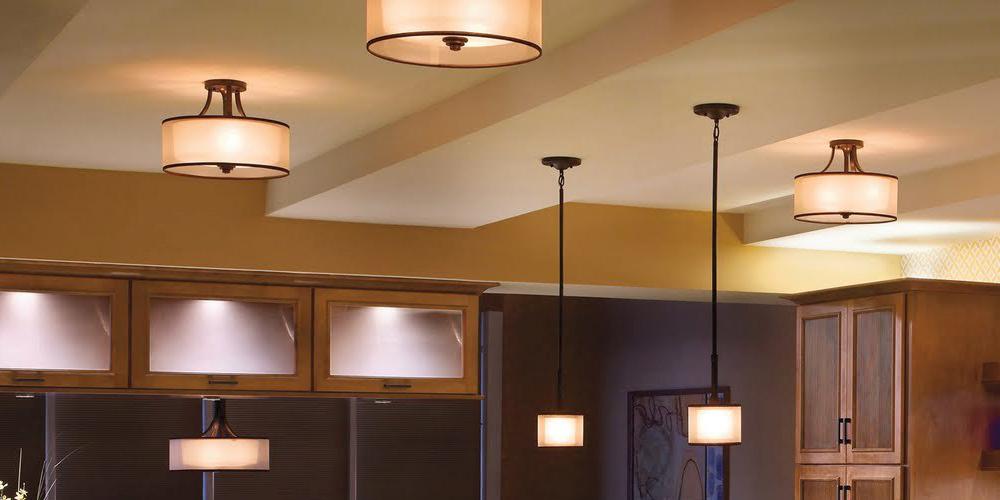
The principal overhead fixtures are chandeliers, pendants, recessed lights, track lights, and flush and semi-flush lights. As the types, sizes, and styles of overhead lights vary greatly, the fixture construction varies greatly as well. All ceiling lights will include a rod, chain, fitter, or trim that securely connects the fixture to the ceiling surface. Other common ceiling light features are:
Overhead lighting fixtures are crafted from a variety of metals, glasses, and plastic materials. The materials used to craft overhead lights depends largely on the application of the light, and the desired aesthetic. Chandeliers may use stylized metals, while recessed can lights may use high-grade plastic. Overhead lights can include fabric shades, though this is less common.
Overhead lighting fixtures include models compatible with almost any type of bulb, including incandescent, LED, and Fluorescent bulbs. These types of fixtures often showcase exposed bulbs, a unique feature of overhead lighting. Ceiling lights with exposed bulbs may use stylized bulbs such as Edison or filament bulbs to achieve a particular look. Each bulb types carries unique advantages and disadvantages.
Silver bowl light bulbs have a metallic finish on their top half for a softer light. These bulbs appear well in overhead fixtures and can compensate for a missing dimmer.
Soft pink light bulbs are tinted with a light pink tone, to create a warm, ambient light. These lights are ideal in any setting where a more rosy, romantic ambiance is desired.
Round candelabra bulbs are intended for use in open-bulb fixtures. These bulbs carry a sleek, modern look that contributes to the overall appearance of a room.
Flame-shaped bulbs imitate the look of a small candle flame. These bulbs were originally used as replacements for candles in the early 20th century and can today add to a vintage aesthetic.
The Edison bulb has become popularized in industrial or factory design. These heritage-style bulbs feature a slender shape with visible glowing filaments. Edison bulbs are expensive, not highly illuminating, and have short lives.
Overhead lights are either low voltage or high voltage. High voltage lights, also known as line voltage lights, are more common in indoor setting. High voltage is defined at 120 volts. Low voltage is defined as 10V, 12V, or 24V. The wiring for overhead lights is often installed during construction of a home, and concealed above the visible ceiling surface, for an unobstructive appearance. Low and high voltage lights have unique benefits and deterrents, and each are best suited to particular applications.
High voltage lights are defined as 120V. Most indoor overhead lights are high voltage, with exceptions. These types of lights do not require the use of a transformer. While transformers are commonly nested inside the fixture canopy in low voltage lights, they can influence the appearance of the light where it attaches to the ceiling.
Low voltage lights are defined at 10V, 12V or 24V. Low voltage fixtures are a modern option, and were not previously available. Low voltage lights include a low voltage fixture and a transformer or power pack. Transformers are commonly nested within the main body of the fixture and do not require special installation. Chandeliers and recessed can lights are commonly low voltage. Low voltage lights allow the use of smaller and more compact bulbs, making low voltage lights a preferred option with candelabra bulb chandeliers and small recessed lights.
Note: Always consult a professional lighting electrication before purchasing or installing overhead lights. This guide is not intended to take the place of a professional's best opinion or serve as a technical safety manual.
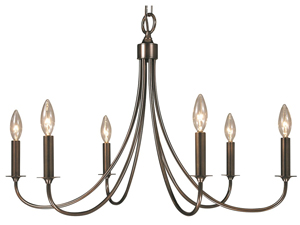
Chandeliers are often installed as showpiece lighting fixtures, making a bold decorative statement in any setting. Smaller chandeliers with a more subtle appearance are also available. Popular in formal dining rooms, foyers, and living rooms, chandeliers commonly include a canopy, chain, central body (otherwise known as the dish), arms, and bulbs. Chandeliers often have an ornate, intricate appearance, though simple, modern options are also available. Chandeliers can be high or low voltage. Low voltage chandeliers allow for smaller, more diverse bulb sizes. Chandeliers with crystal prisms further reflect and distribute light in a room.
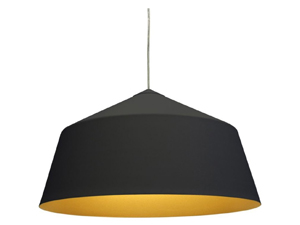
Pendant lights include a rod or chain suspending the fixture housing and bulb at a designated distance from the ceiling. Typically 2 - 8 pendants are used together, spaced evenly along a ceiling surface for an even distribution of light in a specified area. Ideal for general, task, mood, and decorative lighting, pendant lights appear best when used to counterpoint a specific furnishing or feature. Pendant lights are commonly used above kitchen islands, dining tables, or work spaces. Smaller pendants are popular for use over compact task-oriented spaces, such as the kitchen sink.
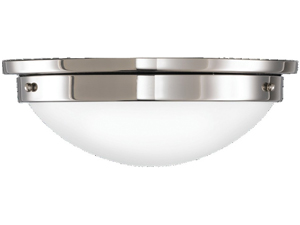
Flush mount lights attach directly to the ceiling, with no space between the ceiling surface and the main body of the fixture. These types of lights do not include a rod or chain. Flush mount lights are ideal in spaces with low ceiling heights, or to achieve a more casual, inconspicuous aesthetic. Flush mount lights are rarely decorative, and serve a primarily functional purpose.
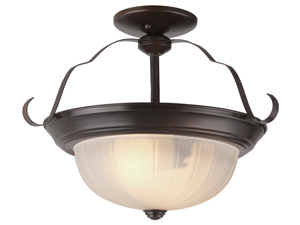
Semi-flush mount lights are similar to flush mount lights, with one notable difference. These types of lights include a rod or chain and are typically suspended 1’ from the ceiling. Flush mount lights create the illusion of a larger, more open room by casting light upwards towards the ceiling, as well as down onto the room. Semi-flush lights offer a more stylized appearance than flush mount options, and can bring full illumination with decorative flair to a dining room, bedroom, or living room.
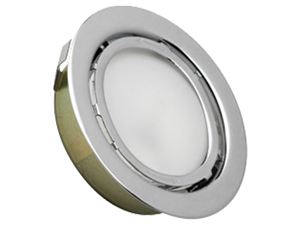
Recessed lights are embedded into the ceiling, for a modern look and highly-illuminating general lighting. These types of lights are also referred to as high hats, downlights, or can lights, and generally measure between 3”-6” in diameter. Recessed lights include the light housing and a trim. The housing refers to the actual light fixture, which is situated inside the ceiling and holds the light bulb and the trim. The trim is what is visible of the fixture to a person standing in a room with recessed lighting. Trim types include baffle, eyeball, wall wash, and shower. Trim type determines the appearance of a recessed light, and various trims are best-suited to unique uses. Recessed lights are commonly low voltage. While most recessed lights point directly towards the ground, directional models are also available and can be angled to highlight particular areas or features in a space.
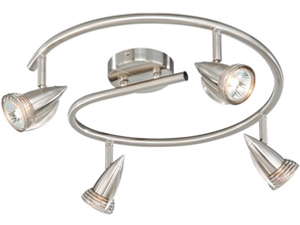
Track lighting refers to a method of lighting where individual fixtures are fixed along one continuous track apparatus. This type of lighting is defined by its concealed conductor, and includes individual spotlights attached to a mounted track. A current runs through the track, allowing flexible positioning of each fixture. Track lighting offers effective accent, task, and ambient lighting, and these types of lights may include straight or curved tracks, and pendant or compact fixtures.
Contemporary fixtures feature sleek lines and straight-forward styling. Geometric shapes, clean finishes, and modern glass are trademark indicators of the contemporary look.
Transitional lights bridge the gap between traditional and contemporary styles, lifting elements from both new and timeless design for a unique aesthetic. These fixtures may include sleek lines with some decorative ornamentation, elegant curved frames, and light detailing.
Traditional fixtures draw upon time-honored motifs for their design. Traditional lights are highly ornamental, and may recall a vintage European aesthetic. Popular features in traditional design include frosted glass, curved frames, and antiqued bronze finishes.
Popular in country or quaint home design, rustic lighting integrates organic shapes, textures, and weathering for a warm, relaxed look with regained modern appeal.
Craftsman lighting design mimic craftsman home design. Straight, simple lines, sharp angles, and contemporary materials are indicators of the craftsman style. Craftsman lights incorporate artistic hand-made style elements, such as painted finishings and seeded glass.
Contemporary industrial style mimics turn-of-the-century factory design, for a gritty, urban look. These lights use patinaed metals, vintage bulbs, and reclaimed motifs to achieve their signature aesthetic.
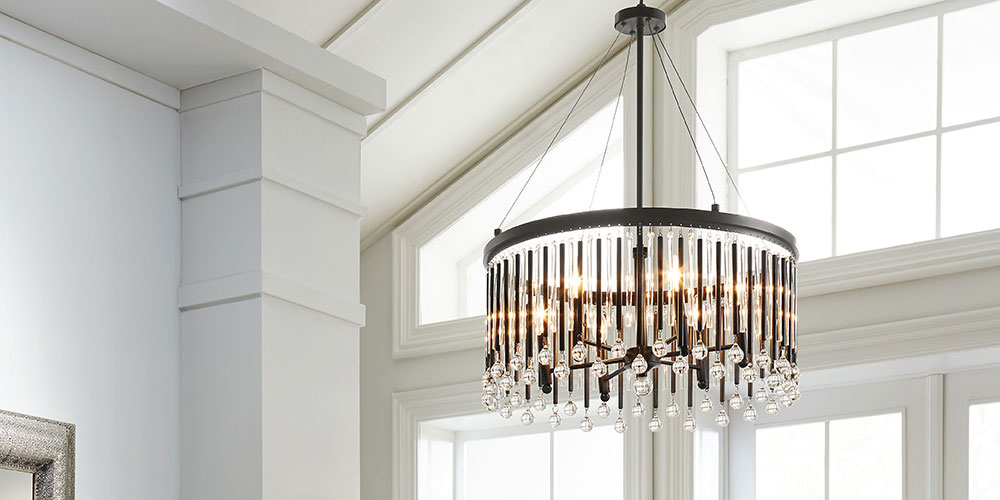
Consider ceiling height when selecting overhead lighting fixtures. Certain overhead lighting types are better-suited to certain ceiling heights. Choosing the appropriate overhead lights for your ceiling height not only adds to a more balanced aesthetic, but also helps to avoid injury from bumping into low-hanging fixtures:



